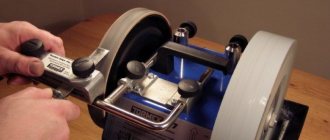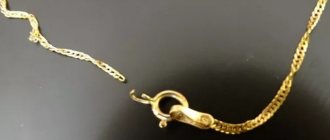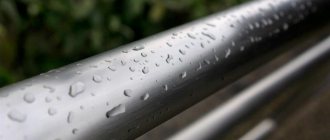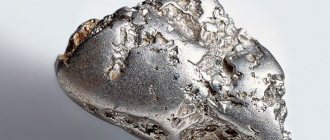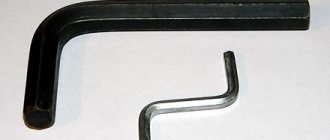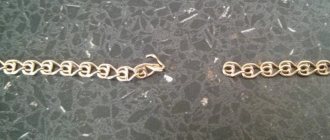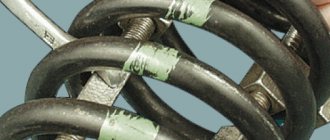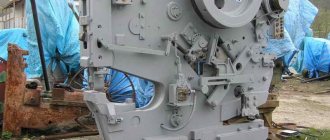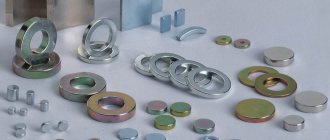30.09.2020
The degree of sharpening of the scissors blade determines how accurately the master will cut the hair, set the degree of angle and, in general, what the client’s hairstyle, mustache, and beard will turn out to be after the work is completed. Even the strongest metal wears out over time and the scissors become dull. You cannot use them further: the result of the work will not satisfy either you or the client.
We'll tell you how to sharpen hair-cutting scissors without turning to professionals, and what you'll need for this.
How to prepare scissors for sharpening
Before you start sharpening, check whether the performance of the blades is actually affected by dullness. Sometimes scissors may not cut well due to the loosening of the connecting element. It could be a bolt or rivet.
After fixing all the problems, cut something and thereby check whether sharpening is needed. If the blades do not cut well, you will need to sharpen them. Before use, wipe the knives with a cotton swab and an alcohol solution. Remove more stubborn stains using suitable chemicals.
Self-sharpening methods at home
There are many ways to sharpen scissor blades at home. To do this, you can use improvised materials that are found in almost every apartment.
Needle or awl
To sharpen you will need a thick needle or awl. The method is quite energy-intensive, so it is suitable for processing small scissors.
Cut the selected item from the rings to the tips of the blades. Try to guide the needle along the sharp edges. Your actions should not be performed through force.
Metal sponge
You can use either new or used metal sponge. The softer the sponge, the better.
Cut the sponge with scissors, using the entire surface of the blades. The more cuts you make, the sharper the blades will be. Please note that during the procedure the sponge crumbles a lot, so it is better to cut directly above the trash can.
Glass jar or bottle
In this procedure, it is best to use an unnecessary jar, since after sharpening there will be scratches on the glass.
- Take the jar in your hand and make the required number of cutting movements. During sharpening, the entire surface of the blades should touch the glass.
- After work, carefully remove small glass fragments from the surface of the blades.
- If you need to sharpen small scissors, use a glass bottle with a narrow neck.
Foil
Take a sheet of foil and fold it into 6-8 layers. You should get a fairly dense layer. Cut the foil into small strips, using the entire surface of the blades. The duller the knives, the more cuts you need to make.
Special sharpeners
A special sharpener can be purchased at a hardware or construction department or ordered from an online store.
Open the scissors and slide each blade through the designated hole. Do the required number of passes until the blades become sharp.
Sandpaper
Like other available materials, scissors are sharpened with sandpaper by cutting it. First, fold the paper in half with the rough side facing out and cut into small strips.
The finer the sandpaper grains, the better. The ideal option would be zero-grit sandpaper.
File
Open the scissors to their maximum width and hold with your hand where the blades meet. This will allow each half to hold tightly and not become loose during the procedure.
File the inside of each blade at a 70 to 80 degree angle. Make movements either only from yourself, or only towards yourself. Never saw the blades by jerking back and forth. Just a few movements are enough to sharpen.
If you cannot hold the scissors tightly with your hand, use a vice.
Grindstone
A similar stone can be purchased at a hardware store or hardware store. Before sharpening, separate the scissors into their component parts by unscrewing the central screw. Apply each blade in turn to the stone with its sharp side and make several movements towards or away from you until the desired sharpness is achieved. At the end of the procedure, assemble the halves by connecting them with a central screw.
Grinder
To use a sharpening machine, sufficient experience and dexterity is required.
The machine is a device with a rotating abrasive wheel. Simply turn on the device and place the halves on the sharpening disc.
In the procedure, it is extremely important to know what angle must be maintained between the blade and the wheel, as well as how long to sharpen, so if you are not familiar with the device, give preference to another method.
Paper clip
Please note that the larger the paperclip, the better.
Hold the paper clip tightly with the tips of the blades and slowly, squeezing the scissors with your fingers, draw it to the base. Repeat the procedure until the scissors are sharp enough. You'll know the scissors are sharpening when you notice small nicks in the paper clip.
Battery
In a similar way to a paper clip, you can sharpen scissors using an unnecessary AA battery. Please note that the battery must be in a metal casing. Clamp the battery with the blades and move it to the base the required number of times.
Screwdriver
Since the paperclip or battery is quite small, it can be replaced with a screwdriver to sharpen larger scissors. Place the screwdriver, metal side down, on a hard surface. Pinch it with the tips of the blades and slowly move it to the base. Repeat as many times as needed to keep the blades sharp.
Where can you sharpen scissors?
Typically, this service is provided in key-making or shoe repair shops. The cost of sharpening scissors is from 50 rubles, depending on the complexity of the service.
Subtleties of the sharpening process
Depending on the type and purpose of the scissors, sharpening may have some subtleties and nuances.
Regular
Scissors that cut paper or other materials can be sharpened at home, spending very little time. Use foil, sandpaper, or another metal-coated object to sand the blades.
Kitchen
At home, it is best to sharpen kitchen scissors in a way that does not require disassembling them. Foil, sandpaper or metal sponge work well. However, such sharpening will not provide long-term results. For better processing, contact professionals.
Manicure
High-quality manicure scissors are quite difficult to sharpen at home. To do this, you need to know how to properly tighten the connecting element and what the sharpening angle should be. The blades are processed with a special diamond needle file from base to tip.
Hairdressers
Hair cutting scissors are made from high-quality materials, as they are designed for a long service life. Properly sharpening blades at home is very difficult and risky. Entrust sharpening to a professional who uses special laser equipment for the job.
Thinning
Thinning scissors have a special structure. They consist of double blades - serrated and straight. It is impossible to sharpen such an item at home, since the work requires certain equipment and knowledge.
Tailor's
It is extremely important when sharpening fabric scissors not to leave jagged edges on the blades, so use smoother materials for processing, such as foil or zero-grade sandpaper. After sharpening, be sure to check the quality of the cut on an unnecessary piece of fabric.
If these are zigzag scissors for processing the edges of fabric, then they can only be sharpened in a workshop.
Garden
For sharpening, you can use a whetstone or a machine. Disassemble the scissors into their component parts and sharpen them accordingly.
Metal scissors
To process metal scissors, be sure to maintain a sharpening angle of approximately 75 degrees. In preparation, separate the blades by unscrewing the connecting bolt. You can sharpen knives with a file or sandpaper. After the procedure, treat the parts with an anti-corrosion agent to extend their service life.
Sheep
Such scissors require maximum sharpness, so processing with foil or sandpaper will not work. Blades must be sharpened using a machine with an abrasive wheel. Process each blade separately, opening the halves as wide as possible.
Non-separable
Scissors cannot be disassembled without a connecting bolt. For sharpening, choose simple methods that do not require separating the halves, such as using a needle, foil or sandpaper.
Rules for working from home
Regardless of what sharpening device you use, you need to learn how to sharpen scissors correctly. Only then can you count on results. It is important to remember four rules.
- Always take into account the factory sharpening angle. You can sharpen yourself only at the angle specified by the manufacturer. Violation of the rules leads to irretrievable loss of the instrument.
- Sharpen "at yourself." You need to watch your movements and avoid algorithms. The tool is sharpened from the “nose” to the rings.
- Fight hangnails. If burrs remain after sharpening, they must be removed with a fine-grained abrasive. The exception is a hairdressing tool: a “small” bar can make it too sharp.
- Check the work. Checking is a cut in the material for which the tool is intended. For example, for tailor's scissors - a cut along the fabric. You need to take a thin piece of paper, hang it up and try to cut it. Smooth cuts, and the blades don’t “bite” the material? It means you did your job well.
If the design of the scissors allows, it is necessary to “disassemble” them. To do this, remove the securing bolt. The blades are sharpened separately: this is more convenient and the result is better.
What not to do when sharpening scissors
To avoid ruining the sharpness of the blades:
- Do not try to sharpen non-standard scissors (hairdressing scissors, thinning scissors, manicure scissors) yourself. Their sharpening requires the use of professional equipment.
- Maintain the sharpening angle corresponding to the factory one. If handled incorrectly, the blades will become unusable.
- Do not disassemble the scissors if you are not sure that you can put them back together.
Why don't scissors cut?
It happens that the blades retain their former sharpness, but the scissors still do not cut. In such cases, you need to check for a gap between the knives and also see if the cutting edge is broken.
How does a gap occur?
Due to increased loads, over time, the connection of the halves weakens slightly and a gap appears between the blades. Sometimes it happens that the metal of the knives becomes slightly deformed. To ensure that the scissors cut well again, adjust the mount or align the blades.
Cutting edge irregularities
Over time, the metal of the blades wears out and becomes deformed. To level the cutting edge, you should contact a professional craftsman who will sharpen and polish the surface of the edge.
How to adjust blade stroke
To adjust the fastener that affects the gap:
- If it is a bolt, carefully tighten it using a small screwdriver. Be careful not to over-tighten; if you tighten too much, the halves won't be able to move.
- If the connection is a rivet, open the scissors and place it on a metal surface. Then use a few blows of a hammer to flatten the plug.
- If there is a stop at the junction of the halves, open the scissors and carefully sharpen it.
Grindstone
This method is more complicated than the previous ones, but also more effective. Place the whetstone on a towel and lightly wet it. In accordance with the factory sharpening angle, place the scissors on the rough part of the whetstone so that the plane forms an acute angle with the surface of the stone. Sharpen in a motion away from you toward the center of the stone, making sure that the entire cutting edge extends from the edge of the whetstone to its center. Then go over the fine-grained side of the stone for additional sanding.
Photo: pinterest.com
How to keep scissors sharp at home
To keep your blades sharp for as long as possible, follow these simple rules for using them:
- Do not use boiling to disinfect. It is better to wipe the blades with an antiseptic.
- Treat the mechanism for connecting the halves with any oil once every 6 months.
- Use scissors only to cut materials that are suitable for their intended purpose.
Always wipe the blades with a piece of cloth after use. Store scissors in a special case and do not allow liquids to come into contact with the knives.
If you liked the article, please share it
Previously on the topic:
- Where are fake shoes sold and who buys them: ways to distinguish a fake...
- Why do I have nightmares, overeating and other common causes of constant...
- How not to wake up at night - working methods, reasons for waking up
- Just give...
- Which cottage cheese is healthier to eat before and after training, which cottage cheese...
- Covid complications: on New Year's Eve, Latvians buy food, not clothes
- What happens if you do the same exercises for six months: how not to lose...
- Age and appetite, why teenagers want to eat a lot, reasons for loss...
Share
How to remove rust from scissors
If the metal is covered with rust, it can be removed using special or improvised means. Special substances easily cope with plaque and do not spoil the metal. However, such funds are not always available at hand, and they are quite expensive.
An alternative to store bought substances can be substances that are available in almost every apartment. You can remove rust with:
- slurry of water and soda;
- solution of citric acid or vinegar;
- peeled potatoes.
If the rust has not yet become deeply ingrained into the metal, the blades can be cleaned with sandpaper or a metal sponge.
Scissors are a simple item that requires simple operating rules. Some types of them require special sharpening only in professional workshops. To process regular blades, you can use materials that are always on hand. At the same time, the procedure does not require any special skills from you, and also will not take much effort and time.
Sandpaper
How to sharpen scissors with sandpaper? Follow these steps:
- Take medium abrasive sandpaper (grain size 150–200 microns).
- Fold the sheet in half, rubbing side up.
- Cut about 10–20 strips, using the entire length of the edges.
The procedure takes only a few minutes. You can cut steel wool or kitchen sponge from steel fibers with the same result.
Sandpaper for sharpening scissors: Pixabay
